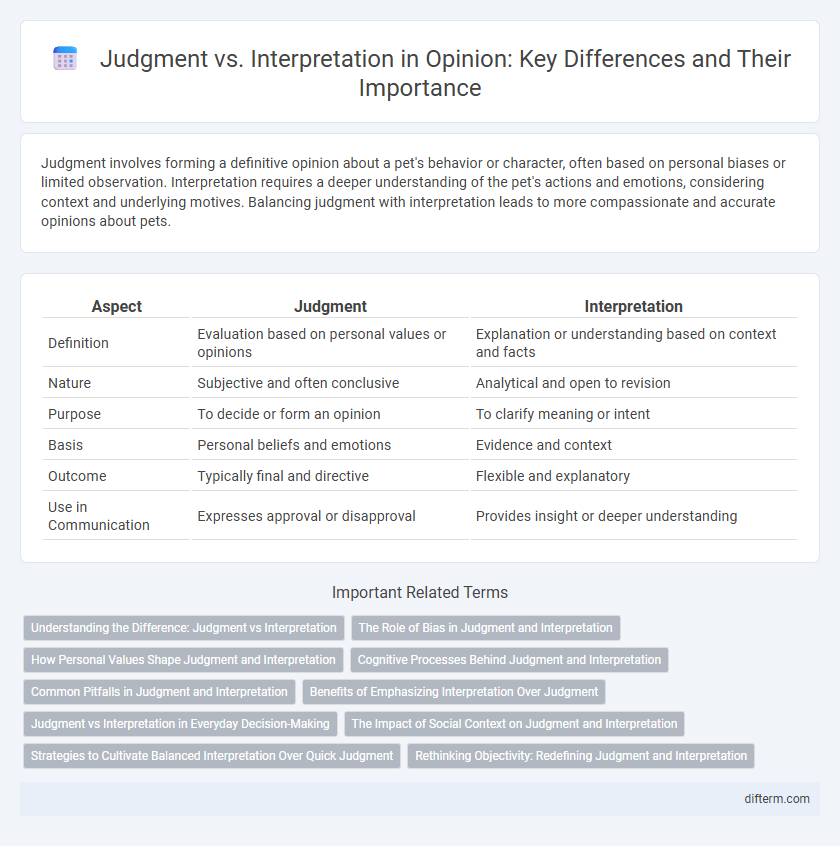Judgment involves forming a definitive opinion about a pet's behavior or character, often based on personal biases or limited observation. Interpretation requires a deeper understanding of the pet's actions and emotions, considering context and underlying motives. Balancing judgment with interpretation leads to more compassionate and accurate opinions about pets.
Table of Comparison
| Aspect | Judgment | Interpretation |
|---|---|---|
| Definition | Evaluation based on personal values or opinions | Explanation or understanding based on context and facts |
| Nature | Subjective and often conclusive | Analytical and open to revision |
| Purpose | To decide or form an opinion | To clarify meaning or intent |
| Basis | Personal beliefs and emotions | Evidence and context |
| Outcome | Typically final and directive | Flexible and explanatory |
| Use in Communication | Expresses approval or disapproval | Provides insight or deeper understanding |
Understanding the Difference: Judgment vs Interpretation
Judgment involves forming an opinion or conclusion about the value or nature of something, often based on personal beliefs or emotions. Interpretation requires analyzing and explaining the meaning behind information or events, emphasizing objectivity and context. Recognizing this distinction enhances critical thinking and fosters clearer communication.
The Role of Bias in Judgment and Interpretation
Bias significantly influences both judgment and interpretation by shaping how information is perceived and evaluated. Judgment often reflects personal or cultural biases that lead to subjective conclusions, whereas interpretation involves assigning meaning that may be skewed by unconscious prejudices. Understanding the role of bias is crucial to fostering critical thinking and minimizing errors in decision-making processes.
How Personal Values Shape Judgment and Interpretation
Personal values significantly influence judgment and interpretation by filtering experiences through unique belief systems and cultural backgrounds. These values act as cognitive frameworks that determine what information is emphasized or downplayed when assessing situations or texts. Consequently, two individuals exposed to the same event may arrive at divergent conclusions shaped by their distinct moral priorities and life experiences.
Cognitive Processes Behind Judgment and Interpretation
Judgment involves evaluating information to make decisions, relying heavily on analytical thinking and critical assessment of evidence. Interpretation focuses on assigning meaning to ambiguous or complex stimuli, engaging cognitive processes like pattern recognition and contextual integration. Both processes activate different neural pathways, with judgment tapping into executive functions and interpretation involving memory retrieval and semantic processing.
Common Pitfalls in Judgment and Interpretation
Common pitfalls in judgment include confirmation bias, where individuals favor information that supports pre-existing beliefs, and overgeneralization, which leads to inaccurate conclusions from limited evidence. Interpretation often suffers from semantic ambiguity and contextual misunderstanding, causing miscommunication and flawed analysis. Both judgment and interpretation require critical thinking and awareness of cognitive biases to improve accuracy and objectivity.
Benefits of Emphasizing Interpretation Over Judgment
Emphasizing interpretation over judgment fosters open-mindedness and encourages deeper understanding of diverse perspectives. Interpretation prioritizes context and intent, which reduces bias and promotes empathy in communication. This approach enhances problem-solving by allowing more nuanced analysis rather than rigid conclusions.
Judgment vs Interpretation in Everyday Decision-Making
Judgment involves evaluating information to form a definitive conclusion, while interpretation pertains to understanding and explaining meaning based on context. In everyday decision-making, effective judgment relies on accurate interpretation of cues, data, and experiences to guide actions. Distinguishing between these processes enhances clarity and reduces errors in personal and professional choices.
The Impact of Social Context on Judgment and Interpretation
Judgment and interpretation are profoundly influenced by social context, which shapes the frameworks through which individuals assess information and assign meaning. Cultural norms, group dynamics, and prevailing societal values act as filters that alter both the criteria for evaluating situations and the lens for understanding ambiguous data. This social embedding leads to variability in judgment and interpretation across different communities, highlighting the importance of context in making informed, balanced decisions.
Strategies to Cultivate Balanced Interpretation Over Quick Judgment
Cultivating balanced interpretation over quick judgment involves actively practicing empathy by considering multiple perspectives before forming conclusions. Employing mindfulness techniques helps slow cognitive biases, allowing for a more reflective and nuanced understanding of situations. Engaging in critical thinking and seeking clarifying questions promotes deeper comprehension, reducing the likelihood of premature or inaccurate judgments.
Rethinking Objectivity: Redefining Judgment and Interpretation
Rethinking objectivity challenges traditional distinctions between judgment and interpretation by emphasizing their interdependence in knowledge formation. Judgment involves evaluating evidence with bias awareness, while interpretation requires contextual understanding to ascribe meaning. This redefinition promotes a balanced approach, integrating subjective insight with empirical rigor to enhance critical analysis.
judgment vs interpretation Infographic

 difterm.com
difterm.com